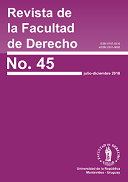Incorporación de la diversidad genérico-sexual en salud:
claves teóricas para un modelo analítico
Resumen
En este trabajo se analizan los desafíos que presenta la incorporación del enfoque de diversidad sexual y de género en una política sectorial, la política sanitaria, desde una perspectiva que implica transversalizar dicho enfoque en las principales dimensiones asociadas a los conceptos centrales con los que se construye universalidad e integralidad en esta arena de política.
Para ello, el artículo comprende cuatro secciones. En la primera se ofrece una introducción general sobre el tema. En la segunda sección se abordan cambios y reconfiguraciones sustantivas que implicaron un cuestionamiento de las bases de legitimidad de las políticas universalistas del bienestar, al problematizar asuntos que, hasta entrado el siglo XX, eran invisibilizados por la política pública. En la tercera se profundiza sobre la inclusión de la perspectiva de la diversidad genérico-sexual en salud. Allí se realiza una revisión crítica de la literatura sobre sistemas de salud y políticas sanitarias, así como se profundiza sobre la literatura que se enfoca en introducir la perspectiva de la diversidad sexual en el análisis de los sistemas de salud y de las políticas sanitarias, para posteriormente abordar el enfoque del mainstream de género, explorando su potencialidad analítica para el estudio de la incorporación de la perspectiva de diversidad genérico-sexual en el ámbito de la política sanitaria y de los sistemas de salud.
El artículo concluye con una sección en la que se ofrece un modelo teórico propio de transversalización de la perspectiva de diversidad genérico-sexual en conceptos clave de la política sanitaria.
Descargas
Citas
Aguilar Villanueva, L. (1993). Problemas públicos y agenda de gobierno. México DF: Porrúa.
Beagan, B., Fredericks, E. y Goldberg, L. (2012). Nurses work with LGBTQ patients: “they’re just like everybody else, so what’s the difference?” Can J Nurs Res, (2012)44, 44–63.
Beramendi, C. (2012). Una visita al mainstreaming de género desde el contexto. Cuarto Congreso Uruguayo de Ciencia Política, “La Ciencia Política desde el Sur”, Asociación Uruguaya de Ciencia Política, 14-16 de noviembre de 2012. Recuperado de http://www.aucip.org.uy/docs/cuarto_congreso/13131712%20-%20Beramendi,%20Carmen.pdf
Betone, C., et al. (2012). Aportes para la atención de la salud integral de personas trans desde una perspectiva local. Recuperado de http://www.rosario.gov.ar/sitio/verArchivo?id=6893&tipo=objetoMultimedia
Betti, L., et al. (2011). El acceso a la atención de la salud de la población de la diversidad sexual. Construcción de políticas públicas a partir de un diagnóstico participativo.
Butler, J. (1988). Performative Acts and Gender Constitution: An Essay in Phenomenology and Feminist Theory. Theatre Journal, (40)4, 519-531.
Butler, J. (2001). El género en disputa: El feminismo y la subversión de la identidad. Ciudad de México: Paidós.
Butler, J. (2002). Cuerpos que importan: sobre los límites materiales y discursivos del sexo. Buenos Aires: Paidós.
Cáceres, C., et al. (2008). Review of Legal Frameworks and the Situation of Human Rights related to Sexual Diversity in Low and Middle Income Countries. Geneva, Switzerland: UNAIDS.
Cáceres, C., et al. (2013). Diversidad sexual, salud y ciudadanía. Rev. peru. med. exp. salúd publica, 30(4), 698-704.
CIDH (2015). Violencia contra Personas Lesbianas, Gay, Bisexuales, Trans e Intersex en América. Recuperado de http://www.oas.org/es/cidh/informes/pdfs/violenciapersonasLGTBi.pdf
Coll-Planas, G. y Missé, M. (2015). La identidad en disputa. Conflictos alrededor de la construcción de la transexualidad. Papers : revista de sociologia, (100)1, 35-52.
Colpitts, E. y Gahagan, J. (2016). I feel like I am surviving the health care system: understanding LGBTQ health in Nova Scotia, Canada. BMC Public Health. Recuperado de https://bmcpublichealth.biomedcentral.com/articles/10.1186/s12889-016-3675-8
Crenshaw, K. (1989). Demarginalizing the Intersection of Race and Sex: A Black Feminist Critique of Antidiscrimination Doctrine, Feminist Theory and Antiracist Politics. University of Chicago Legal Forum, (1989)1, 8. Recuperado de http://chicagounbound.uchicago.edu/uclf/vol1989/iss1/8
Daley, A. y MacDonnell, J. (2011). Gender, sexuality and the discursive representation of access and equity in health services literature: implications for LGBT communities. Int J Equity Health. (2011),10-40.
De Barbieri, T. (1999). Derechos sexuales y reproductivos. Aproximación breve a su historia y contenido. Mujer y Salud, 2.
Elder, C. y Cobb, R. (1993). Formación de la agenda. El caso de la política de ancianos. En L. Aguilar Villanueva (ed) Problemas públicos y agenda de gobierno. México DF: Porrúa.
Fish, J. (2007). Getting equal: the implications of new regulations to prohibit sexual orientation discrimination for health and social care. Diversity in Health and Social Care, 4, 221–8.
Foucault, M. (1995). Historia de la sexualidad. 1: La voluntad de saber. Madrid: Siglo XXI.
Fraser, N. (2000). Nuevas reflexiones sobre el reconocimiento. New Left Review, 3, 55-68.
García Prince, E. (2008). Políticas de igualdad, equidad y gender mainstreaming. ¿De qué estamos hablando? Marco conceptual. Recuperado de http://pmayobre.webs.uvigo.es/descargar_libros/evangelina_garcia_price/politicas.pdf
Giovanella, L., et al. (2012). Sistemas de salud en Suramérica: desafíos para la integralidad y la equidad. Río de Janeiro: Instituto Suramericano de Gobierno en Salud,
Goffman, E (1963) Stigma: Notes on the Management of Spoiled Identity, Prentice-Hall.
Gott, M., et al. (2004). Opening a can of worms: GP and practice nurse barriers to talking about sexual health in primary care. Fam Pract, 21(5), 528-536.
Gulliford, M. Figueroa-Muñoz, J. y Morgan, M. (2003). Introduction: meaning of "access" in health care. En M. Gulliford y M. Morgan (eds) Access to health care. Nueva York: Routledge.
Hall, P. (1993). Policy paradigms, social learning and the state: the case of economic policy-making in Britain. Comparative politics, 25(3), 275-296.
Harris, R. (2013). Operationalisation of the construct of access to dental care: a position paper and proposed conceptual definitions. Community dental Health, 30, 94-101.
Honneth, A. (1997). La lucha por el reconocimiento (Trad. española de M. Ballestero). Barcelona: Crítica.
Jackson, B., et al. (2006). Whose Public Health? An Intersectional Approach to Sexual Orientation, Gender Identity and the Development of Public Health Goals for Canada. (Discussion Paper submitted to Health Canada), Rainbow Health Network (RHN)/Coalition for Lesbian and Gay Rights in Ontario (CLGRO), Toronto.
Kingdon, J. (1995). Agendas, alternatives, and public policies. Nueva York: Harper Collins.
Kraft, M. y Furlong, S. (2006). Public Policy: Politics, Analysis and Alternatives. Washington, DC: CQ Press.
Levesque, J.-F., Harris, M. F. y Russell, G. (2013). Patient-centred access to health care: conceptualising access at the interface of health systems and populations. International Journal for Equity in Health, 12, 18. http://doi.org/10.1186/1475-9276-12-18
Mahoney, J. (2000). Path dependence in historical sociology. Theory and society, 29(4), 507-548.
Makadon, H. (2011). Ending LGBT invisibility in health care: The first step in ensuring equitable care. Cleveland Clinic Journal of Medicine, 78(4), 220-224.
Marshall, T. H. y Bottomore, T. B. (1998). Ciudadanía y clase social. Madrid: Alianza.
Mendoza Parra, S. (2016). Cobertura, acceso y equidad universal en salud, una caracterización de la producción científica de enfermería. Rev Latino-Am Enfermegem, 24.
Mohoney, J. y Thelen, K. (2010). Explaining institutional change. Ambiguity, agency and power. Cambridge: Cambridge University Press.
Mooney, G. (1983). Equity in health care: confronting the confusion. Effective Health Care, 1, 179-85.
Mulé, J., et al. (2009). Promoting LGBT health and wellbeing through inclusive policy development. International Journal for Equity in Health, (2009)8,18. Recuperado de http://www.equityhealthj.com/content/8/1/18
Núñez, G. (2007). Masculinidad e intimidad: identidad, sexualidad y sida. Universidad Nacional Autónoma de México. México DF: Programa Universitario de Estudios de Género.
OMS (2016). FAQ on Health and Sexual Diversity - An Introduction to Key Concepts. Ginebra: OMS.
OPS (2013). Documento CD52/18 del 52º Consejo Directivo de la OPS.
OPS (2014). Estrategia para el acceso universal a la salud y la cobertura universal de salud. Documento del 53º Consejo Directivo de la OPS.
Pechansky, R. y Thomas, W. (1981). The concept of access. Medical Care, 19, 127-40.
Pierson, P. (2000). Increasing returns, path dependence and the study of politics. The American Political Science Review, 94(2), 251-267.
Plummer, K. (1995). Intimate citizenship: private decisions and public dialogues. Washington, DC.: University of Washington Press.
Rich, A. (1980). Compulsory Heterosexuality and Lesbian Existence. Signs: Journal of Women in Culture and Society, 5, 631-60.
Saltzman, J. (1992). Equidad y Género. Madrid: Cátedra Universitat de Valencia, Instituto de la Mujer.
Scott, J. (1996). El género: Una categoría útil para el análisis histórico. En M. Lama (comp.) El género: la construcción cultural de la diferencia sexual. México DF: PUEG.
Sedgwick, E. K. (1998). Epistemología del armario. Barcelona: Ediciones de la Tempestad.
Sempol, D. (2013a). De los baños a la calle. Historia del movimiento lésbico, gay, trans uruguayo (1984-2013). Montevideo: Random House Mondadori.
Sempol, D. (coord.) (2013b). Políticas públicas y diversidad sexual. Análisis de la heteronormatividad en la vida de las personas y las instituciones. Montevideo: Ministerio de Desarrollo Social.
Sempol, D., Calvo, M., Rocha, C. y Schenck, M. (2016). Corporalidad trans y abordaje integral. El caso de la Unidad Docente Asistencial Saint Bois. Montevideo: Ministerio de Desarrollo Social.
Steinmo, S. y Watts, J. (1995). It's the institutions, stupid! Why the United States can't pass comprehensive National Heath Isurance. Journal of Heath Politics Policy and Law, 20(2), 329-372.
Streek, W. y Thelen, K. (2005). Beyond continuity. Institutional change in advanced political economies. Nueva York: Oxford University Press.
Toro, J. (2012). El estado actual de la investigación sobre la discriminación sexual. Terapia Psicológica, (30)2, 71-76.
Ulin, P., Robinson, E. y Tolley, E. (2006). Investigación aplicada en salud pública. Métodos cualitativos. Washington DC.: OPS.
Verloo, M. (2005). Mainstreaming Gender Equality in Europe. A Frame Analysis Approach. The Greek Review of Social Research. Special Issue: Differences in the Framing of Gender Inequality as a Policy Problem across Europe, 117(2), 11–34.
Vignolo, J., Vacarezza, M., Álvarez, C. y Sosa, A. (2011). Niveles de atención, de prevención y atención primaria de la salud. Archivos de Medicina Interna, 33(1), 7-11. Recuperado de http://www.scielo.edu.uy/scielo.php?script=sci_arttext&pid=S1688-423X2011000100003&lng=es&tlng=es.
Warner, M. (1990). Introduction: Fear of a Queer Planet. Social Text, 9(4), 3-17.
Weeks, J. (1998). The sexual citizen theory. Culture and society, 15, 35-51.
Weeks, J. (1986). Sexuality. London: Routledge.
Whittemore, R., Chase, S. K. y Mandle, C. L. (2001). Validity in qualitative research. Qualitative Health Research, 11(4), 522-537.
Zola, K. (1981). El culto a la salud y la medicina inhabilitante. En Illich, I et al., Profesiones inhabilitantes. Madrid: Blume Ediciones.
Los autores conservan sus derechos de autor y ceden a la revista el derecho de primera publicación de su obra, el cuál estará simultaneamente sujeto a la licencia Creative Commons Reconocimiento 4.0 Internacional License. que permite compartir la obra siempre que se indique la publicación inicial en esta revista.












